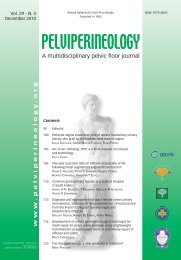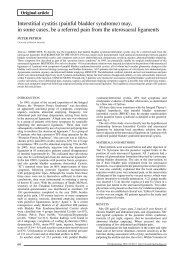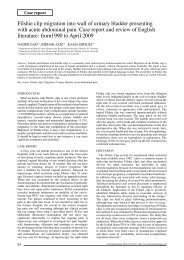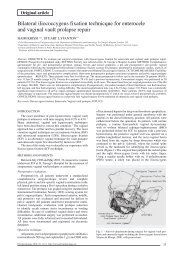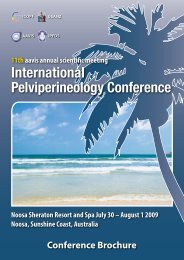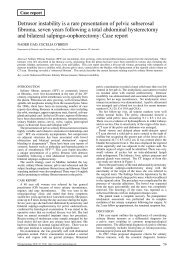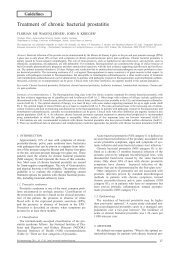This Issue Complete PDF - Pelviperineology
This Issue Complete PDF - Pelviperineology
This Issue Complete PDF - Pelviperineology
You also want an ePaper? Increase the reach of your titles
YUMPU automatically turns print PDFs into web optimized ePapers that Google loves.
Pelvic Floor Digest<br />
<strong>This</strong> section presents a small sample of the Pelvic Floor Digest, an<br />
online publication (www.pelvicfloordigest.org) that reproduces titles and<br />
abstracts from over 200 journals. The goal is to increase interest in all the<br />
compartments of the pelvic floor and to develop an interdisciplinary culture<br />
in the reader.<br />
1 – THE PELVIC FLOOR<br />
Patients’ pelvic goals change after initial urogynecologic consultation. Lowenstein L, Kenton K, Pierce K, Fitzgerald MP, Mueller ER,<br />
Brubaker L. Am J Obstet Gynecol. 2007;197:640. The objective of the study was to determine the effect of initial urogynecologic consultation<br />
on the number and type of patient goals. The number of patients’ postconsultation goals was higher than the number of preconsultation goals.<br />
Women were less likely to report “symptom” and “information-seeking” goals, but more likely to report treatment goals after consultation. It<br />
is important to reassess goals following initial consultation.<br />
Levator avulsion and grading of pelvic floor muscle strength. Dietz HP, Shek C. Int Urogynecol J Pelvic Floor Dysfunct. 2007 Nov 13;<br />
epub. In a retrospective study with 3D/4D translabial ultrasound and digital assessment on 1,112 women, levator avulsion was diagnosed<br />
whenever the examiner was unable to palpate the insertion of the pubovisceral muscle on the inferior pubic ramus and/or whenever a discontinuity<br />
between bone and muscle was detected on ultrasound. Avulsion defects were found in 23%, associated with a highly significant reduction<br />
in the overall Oxford grading. Avulsion of the puborectalis muscle seems to have a marked effect on pelvic floor muscle strength, which<br />
may help in diagnosing trauma.<br />
Effect of biofeedback training on paradoxical pelvic floor movement in children with dysfunctional voiding. de Jong TP, Klijn AJ,<br />
Vijverberg MA et al. Urology. 2007;70:790. Pelvic floor dysfunction occurs frequently in children with dysfunctional voiding and can be cured<br />
by dedicated physical therapy. The clinical importance of this phenomenon is not yet clear.<br />
2 – FUNCTIONAL ANATOMY<br />
The contribution of the levator ani nerve and the pudendal nerve to the innervation of the levator ani muscles; a study in human<br />
fetuses. Wallner C, van Wissen J, Maas Cpet al. Eur Urol. 2007 Nov 20; epub. The levator ani muscle (LAM) often has a dual somatic innervation<br />
with the levator ani nerve as its constant and main neuronal supply. Fetal pelves were studied individually and 3D reconstructions were<br />
prepared. The levator ani nerve innervated the LAM in every pelvis, whereas a contribution of the pudendal nerve to the innervation of the<br />
LAM could be demonstrated in only 10 pelvic halves (56%). No sex differences were observed.<br />
Anatomic relationships of the tension-free vaginal mesh trocars. Chen CC, Gustilo-Ashby AM, Jelovsek JE, Paraiso MF. Am J Obstet<br />
Gynecol. 2007;197:666. The bladder (mean distance 0.7 cm, range, 0.4-1.1) and medial branch of the obturator vessel (0.8 cm, range 0.6-1.0)<br />
may be at risk of injury during the passage of the anterior trocars, whereas the rectum (0.8 cm range 0.6-1.0) and inferior rectal vessels were at<br />
0.9 cm (range 0.7-1.1), may be at risk during the passage of the posterior trocar (study in 8 frozen cadavers).<br />
Anatomic variations of the pelvic floor nerves adjacent to the sacrospinous ligament: a female cadaver study. Lazarou G, Grigorescu<br />
BA, Olson TR eeet al. Int Urogynecol J Pelvic Floor Dysfunct. 2007 Nov 24; epub. The pudendal nerve (PN) was found to pass medial to the<br />
ischial spine (IS) and posterior to the sacrospinous ligament (SSL) at a mean distance of 0.6 cm in 80% of 15 female cadavers. In 40% of<br />
cadavers, an inferior rectal nerve (IRN) variant pierced the SSL at a distance of 1.9 cm medial to the IS. The levator ani nerve (LAN), coursed<br />
over the superior surface of the SSL-coccygeus muscle complex at a mean distance of 2.5 cm medial to the IS. Anatomic variations were<br />
found which challenge the classic description. A nerve-free zone is situated in the medial third of the SSL.<br />
3 – DIAGNOSTICS<br />
Analysis of a computer based simulator as an educational tool for cystoscopy: subjective and objective results. Gettman MT, Le CQ,<br />
Rangel LJ, Slezak JM. J Urol. 2007 Nov 12; epub. Resident education in cystoscopy has traditionally relied on clinical instruction. However,<br />
simulators are now available outside the clinical setting. We evaluated a simulator (UroMentor, Simbionix, Lod, Israel) for flexible and rigid<br />
cystoscopy with 30 novice and 27 expert cystoscopists on a computer based cystoscopic simulator. Objectively, expert and novice performance<br />
of cystoscopic tasks can be distinguished. Subjective assessments suggest ongoing refinement of the simulator as a learning tool for<br />
cystoscopic skills training.<br />
4 – PROLAPSES<br />
Transperineal rectocele repair with polyglycolic acid mesh: a case series. Leventoglu S, Mentes BB, Akin M, et al. Dis Colon Rectum. 2007<br />
Nov 30; epub. In 83 females with predominant, symptomatic rectocele a transperineal rectocele repair was done using polyglycolic acid (Soft<br />
PGA Felt(R)) mesh. Preoperatively, 39 patients had Stage II and 44 patients had Stage III rectocele with a mean total symptom score 9.87 ±<br />
1.93, reduced to 1.62 ± 0.59 at six-month follow-up postoperatively and anatomic cure in 89.2 percent. Hemorrhage (3.6 percent) and wound<br />
infection (4.8 percent) were the surgical complications observed.<br />
Uterosacral ligament suspension sutures: anatomic relationships in unembalmed female cadavers. Wieslander CK, Roshanravan SM,<br />
Wai CY, et al. Am J Obstet Gynecol. 2007;197:672. The of uterosacral ligament suspension (USLS) sutures can directly injure the ureters,<br />
rectum, and neurovascular structures in the pelvic walls. Their anatomic relationships were examined in 15 unembalmed female cadavers. The<br />
mean distance of the proximal sutures to the ureters and rectal lumen was 14 (0-33) and 10 mm (0-33), of the distal ones to the ureters 14 (4-33)<br />
and to the rectal lumen 13 mm (3-23). Right sutures were at the level of S1 in 37.5%, S2 in 37.5%, and S3 in 25% of specimens, left sutures<br />
at S1 in 50%, S2 in 29.2%, and S3 in 20.8%. Of 48 sutures passed, 1 entrapped the S3 nerve, and in 4.1% of specimens the pelvic sidewall<br />
vessels were perforated.<br />
Does supracervical hysterectomy provide more support to the vaginal apex than total abdominal hysterectomy? Rahn DD, Marker AC,<br />
Corton MM et al. Am J Obstet Gynecol. 2007;197:650. In unembalmed cadavers, it appears that total abdominal hysterectomy and supracervical<br />
hysterectomy provide equal resistance to forces applied to the vaginal apex.<br />
Bladder symptoms 1 year after abdominal sacrocolpopexy with and without Burch colposuspension in women without preoperative<br />
stress incontinence symptoms. Burgio KL, Nygaard IE, Richter HE, Brubaker L et al. Am J Obstet Gynecol. 2007;197:647. One year after<br />
abdominal sacrocolpopexy (ASC), irritative, obstructive, and stress urinary incontinence (SUI) symptoms were assessed in 305 women using<br />
Urogenital Distress Inventory subscales. A composite “stress endpoint” combined SUI symptoms, positive stress test, and retreatment. ASC<br />
reduced bothersome irritative and obstructive symptoms and prophylactic Burch reduced stress and urge incontinence.<br />
Bowel symptoms in women 1 year after sacrocolpopexy. Bradley CS, Nygaard IE, Brown MB et al. Am J Obstet Gynecol. 2007;197:642.<br />
Most bowel symptoms improve in women with moderate to severe pelvic organ prolapse after sacrocolpopexy. In a randomized trial of sacrocolpopexy<br />
with or without Burch colposuspension in stress continent women with stages II-IV prolapse, in addition subjects underwent<br />
10<br />
<strong>Pelviperineology</strong> 2008; 27: 10-30 http://www.pelviperineology.org



